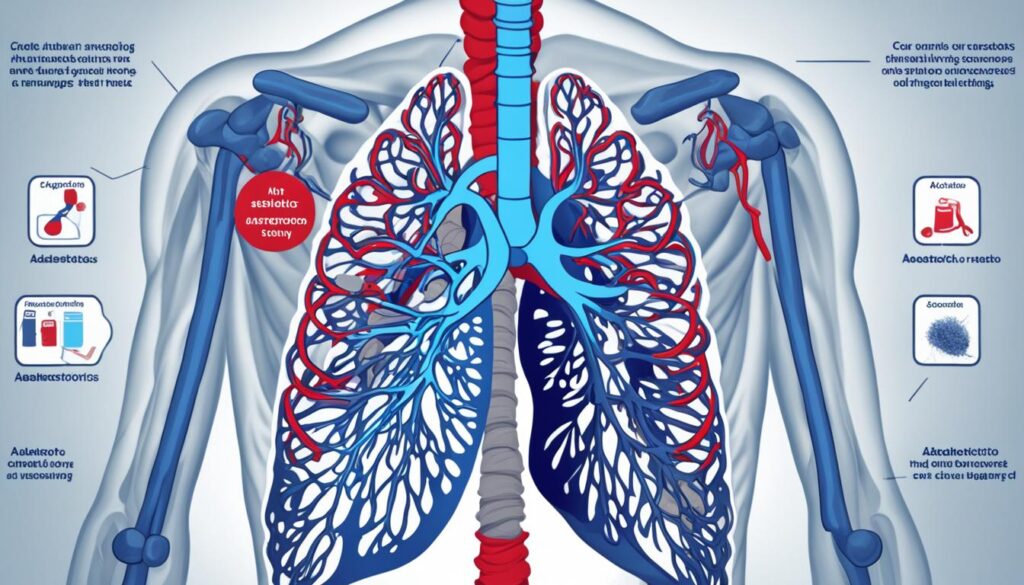In the UK, asbestos exposure is a major health risk. Every year, around 5,000 workers die from diseases linked to asbestos. This number is higher than those killed in road accidents. Understanding and managing the risks is vital to protect our health.
Asbestos consists of minerals that are harmful when we breathe them in. These harmful fibers can float in the air if asbestos-containing materials get disturbed. Diseases like mesothelioma, lung cancer, asbestosis, and pleural thickening can result from exposure.
It’s important to know that buildings made or updated before 2000 might contain asbestos. This makes it crucial to avoid further exposure and take steps to stay safe.
Key Takeaways:
- Asbestos exposure leads to more deaths in the UK than road accidents.
- Illnesses such as mesothelioma and lung cancer can develop from asbestos.
- Asbestos may be found in older buildings.
- We need to handle asbestos exposure carefully to protect ourselves.
- Checking regularly and getting medical advice is key as effects can take time to show.
What is Asbestos and How is it Used?
Asbestos is made of natural minerals with strong fibers. These fibers can resist heat, fire, chemicals, and they don’t let electricity pass through. Because of these traits, many industries want to use asbestos.
There are six asbestos minerals, split into two groups: serpentine and amphibole. The most common type, chrysotile, is in the serpentine group. Amphibole asbestos has minerals like crocidolite, known for their needle shape.
In different fields like construction and car making, asbestos is widely used. It strengthens cement and plastics, insulates buildings, protects against fire, absorbs sound, and is even in products at home, like tiles.
To protect the public, rules were set up in the late 1970s and 1980s. These rules limit asbestos in certain products. For example, using asbestos in wallboard patching and gas fireplaces is banned. Yet, some older uses are still allowed. Schools must check for asbestos and reduce any risks it poses.
Common Uses of Asbestos in Different Industries
| Industry | Common Applications |
|---|---|
| Construction | Roofing materials, insulation, cement reinforcement |
| Shipbuilding | Insulation, fireproofing, adhesives, gaskets |
| Automotive | Brake pads, clutch facings, gaskets |
| Manufacturing | Heating systems, chemical filters, textiles |

The table shows asbestos is key in many industrial areas. Yet, it’s important to balance its benefits with the health risks of exposure.
Who is at Risk of Asbestos-Related Diseases?
Asbestos poses big health risks. This is especially true for those who work around it regularly. Jobs such as construction or mining put people at risk.
Many workers face dangers due to asbestos. This includes occupations like shipbuilding and firefighting. Over time, these individuals may be exposed to asbestos. It’s a serious concern in older buildings where asbestos is often found.
It’s not just workers who are at risk. Their families can be exposed to asbestos too. This happens when workers bring asbestos dust home on their clothes.
People who helped with 9/11 cleanup efforts are also in danger. They were exposed to a lot of asbestos when the Twin Towers fell.

Risk Factors for Asbestos-Related Diseases:
- Occupational exposure to asbestos
- Secondhand exposure to asbestos
- Working in industries such as shipbuilding, mining, manufacturing, construction, demolition, and firefighting
Conclusion
Being around asbestos can be very harmful. It can lead to deadly diseases like mesothelioma and lung cancer linked to asbestos. We must reduce our contact with asbestos to keep healthy.
Even a little bit of exposure, if it happens often, can be bad. It’s important to know the dangers of asbestos. We should handle it carefully.
Usually, being exposed just once to asbestos dust isn’t a big worry. But, during big disasters, exposure can be intense and damaging. Remember, it can take years for symptoms to show. Getting checked regularly and consulting a doctor if you feel unwell is key.
If you’ve been around asbestos, tell your doctor. Make sure to avoid asbestos in the future. Taking safety steps helps avoid serious health issues later.
